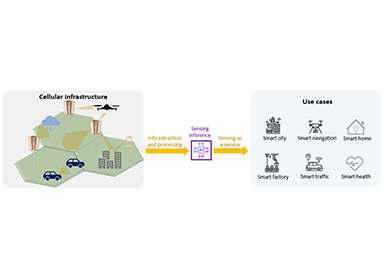Communications
Private 5G in Enterprises – Expanding Opportunities for Vertical Industries
With increasing 5G deployments around the world, I am sure many of us have upgraded to 5G over last few years. We are in the middle of 5th Generation of mobile revolution currently, and even if the upgrade experience may not have been noticeable, 5G is changing the way we live and is penetrating into our life gradually and incrementally.
5G offers much faster speeds than 4G, but operators knew that just “faster speeds” is not going to be the money-spinner for them this time. LTE networks were able to manage HD/4K video streaming services moderately well; it is questionable if applications offering ultimate Metaverse/XR experiences (that are still some time away) will run on 5G, and there isn’t a pressing need of 8K streaming yet. Still all the operators wished to launch 5G networks as soon as possible. Why?
5G promised a new money-spinner – the enterprise networking market, aka Private-5G. It offers the opportunity to explore a new market, and a rich one. Network infrastructure vendors are excited too, they too have an opportunity to explore this rich new market for their products, and offer their solutions to the enterprise/vertical customers.
Why Enterprises/Verticals Want Private Network…
Unlike traditional public networks that services general consumers, a private network is intended for the sole use of a private entity, fully customized for its specific needs. There are several reasons why an enterprise or vertical customer deploys private networks. First, it can provide an optimized and tailored functionalities and services to meet the requirements of each industrial application (e.g. low-latency, reliable transmission and so on). Second, network can be fully and exclusively used, easily deployed, and independently managed by the enterprise. Third, the network is isolated from the public network, so, there is less possibility for sensitive data being leaked outside of the enterprise. Last, it guarantees coverage, especially for mines, agricultural lands, factories, or power plants, which are usually located far from urban area. Since it can be deployed at their facilities or location, they can have reliable network connectivity.

Figure 1. Private Network Ecosystem
Historically...
Wi-Fi has been the preferred choice for enterprise wireless networks for a long time. Relatively cheap to deploy and maintain, it can provide speeds as high as 9.6 Gbps (with Wi-Fi 6). In addition, Wi-Fi networking products have matured with so many customizations over the years that it will take long before an alternate can match their might.
There are use-cases though in which Wi-Fi may not be suitable. Limited coverage and capacity, and lack of QoS assurance are some of the factors that make it not-so-suitable for many enterprises and verticals involved in mission-critical, public safety, defence and manufacturing space, and those requiring e.g. drones and AR/VR/XR based applications, where performance assurance is key.
LTE is another alternative which has gained traction in this space in last few years. It offers QoS centric design, superior coverage and higher level of reliability. With LTE, the throughput capacity of a cell also improved significantly and wide range of sectors started looking more positively at the proposition of private cellular networks for their factories.
A private LTE network can use licensed or shared spectrum and can cater to a wide variety of devices and applications. It can serve devices that require, say, 4K streaming services, and the devices that require low power and low data-rate, simultaneously; it can even be customized to provide different reliability and QoS to different services.
However, there are still some key requirements that the private LTE network cannot meet for enterprises. For example, the concept of private LTE network is not fully standardized one, which means the cost of deployment of the private LTE network can be relatively expensive due to lack of interoperable ecosystem. Additionally, LTE network does not provide specific features (e.g. reliable and low-latency transmission and management of millions of devices and connections) for various applications, such as mission critical services, factory automation services, etc.
Private 5G Explained
3GPP introduced support of "Non-Public Networks (NPN)" in its Release-16 version of specifications, more commonly known as Private 5G. The technology supports URLLC (Ultra Reliable and Low Latency Communication), superior throughput capacity and higher device density as compared to the previous generation which makes it attractive for a number of new use-cases. To add to that, Network Slicing, Edge Computing and Control-User Plane Separation coupled with Network Function Virtualization offer a flexible, extensible and an agile approach to network design, which makes it far more interesting proposition to enterprises.
More importantly, Private 5G introduces native support of NPNs into its architecture and protocols thus avoiding fundamental problems with Private LTE (where support of NPNs was more of an afterthought), while also allowing co-existence with the public networks (PLMNs).

Figure 2(a). SNPNs Figure 2(b). PNI-NPN(s)
Figure 2(a). shows two simplified architectures of Private 5G networks as proposed by 3GPP in its Release-16 and Release-17 versions of specifications. There are two flavours in which private networks can be deployed: Standalone Non-Public Networks (SNPNs) as shown in Figure 2(a). and Public Network Integrated Non-Public Networks (PNI-NPNs) as shown in Figure 2(b).
SNPNs do not rely on network functions provided by a PLMN, and can be deployed and operated by enterprises themselves. The key features of SNPNs are:
● The combination of a PLMN ID and Network Identifier (NID) uniquely identifies an SNPN.
● For network selection, one or multiple PLMN IDs and list of NIDs per PLMN ID are broadcasted by NG-RAN.
● SNPN-enabled User Equipment (UE) is configured with PLMN ID and NID, Subscription identifier (SUPI) and credentials for the subscribed SNPN.
● SNPN-enabled UE supports the SNPN access mode for network selection.
● UE in SNPN access mode can access PLMN services via SNPN network as depicted in Figure 3.

Figure 3. Access to PLMN services via SNPN networks
PNI-NPNs, on the other hand, are integrated with a PLMN networks. The key features of PNI-NPNs are:
● PNI-NPNs can be deployed on a dedicated network-slice or the dedicated DNN within the PLMN network, while re-using the same frequency band as the public networks.
● PNI-NPNs can be identified by a PLMN ID and a Closed Access Group (CAG) Identifier.
● UE is configured with list of allowed CAG Identifiers, and optionally with time validity information.
● CAG cell broadcasts information so that only UEs supporting CAGs can access the cell.
● Emergency Services can be supported in CAG cells.
SNPNs are typically useful when enterprises need a fully isolated network, preferably with its own IT teams managing the infrastructure. PNI-NPNs, on the other hand, are useful when operators lease (part-of) their own infrastructure for exclusive use by a factory site.
Enterprise Services with Private 5G
With specialized Private 5G features, it can provide the enterprises with many useful services. In enterprises, what is the most important service? It might be various types of communication among employees. Thanks to large coverage, high data rate, and QoS of Private 5G, employees can use a normal phone call service and even a high-quality multilateral video call service. They can work anytime and anywhere with their handheld devices using the mobile office connected to company’s cloud.
Private 5G also introduces an easy and convenient on-line instant user subscription feature called UE on-boarding and remote provisioning service. Consider a large number of sensors are to be deployed in the oil refinery company for measuring the amount of oil in every tank. As soon as sensors are deployed, with this feature, they are subscribed to company’s private network automatically.
Another useful feature is the remote user authentication and authorization service. Usually, many enterprises have several branch offices or factories located all over the country. Employees, therefore, may frequently visit another branch office or factory for meeting, cooperative work etc. With the remote user authentication and authorization service using their subscription data and credential in home private network, they can use the visited private network located in other sites like their home network.
Private 5G also provides localized services. When users are in some popular places, such as music concerts, stadiums or exhibition venue, they can use the services which are only provided in those area and at some specific time (e.g. live video streaming service of music concerts). Users without subscription to this network can enjoy this high quality service using this private network.
With all these capabilities, Private 5G offers a complete standards-based architecture, and therefore, can cater to various enterprises such as manufacturing, defence installations, public-safety organisations, stadiums and arenas, mission critical services and hospitals, all requiring different level of security and QoS; seamlessly.
The Road Ahead...
3GPP Rel-18 (aka 5G-Advanced) standards are set to complete by June 2024 with further enhancements, and will be an important milestone enabling a number of new use-cases for wider adoption of this technology. These include, hosting of 3rd party enterprise-grade services on an infrastructure owned by a venue operator (e.g. stadiums, airport) to enable a diverse set of use-cases ranging from temporary data connectivity, temporary events and application based network selection.
Samsung has been committed to the development of standards for Private 5G in 3GPP since initial phases and is an active contributor to support for localized services, security aspects and public-network integrated non-public networks. We firmly believe that Private 5G can be an important alternate revenue source for Mobile Network Operators (MNOs) as well as the Infrastructure Vendors.






